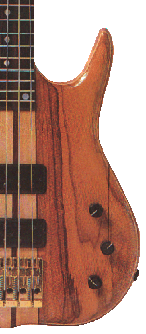
Making Your First Guitar
A Tutorial
Drafting Your Project
Now that you have an idea of what you want to create, it's time to plot out the blueprint. Those without drafting experience need not be intimidated for we just don't need something akin to the architectural design of the World Trade Center, but rather a drawing representing the basic shape and outline of your bass to be used as a reference for your collection of measurements.
I prefer to do a drawing full scale on paper as this gives me a better perspective as to how the instrument will look when finished and I can usually place the hardware right on the drawing to see how it will look, or to calculate various angles (more later). I like to use drafting Velum which is available at drafting supply stores, art stores or office supplies, such as Business Depot, Office Depot or Staples. The Velum is semi-transparent, so that tracing through it is easy, it has rag fiber in it which makes it durable and it erases cleanly. Using a pencil and some "french curves", draw your instrument's outline on the page. (Those with computer experience can proceed on their own using the program of their choice. As I haven't mastered CAD-based programs, yet, I won't comment further on this other than to say it has, no doubt become the future of the art.)
It would also be advantageous to have purchased your hardware in advance as this will allow you to make crucial decisions and measurement, the most important of which will be the neck angle. The neck angle is to a great deal responsible for the action of the completed instrument. A bass with strings parallel to the fingerboard and at the optimal distance above it will be much more pleasant to play than one that fights back! Depending on the manufacturer, the bridge (saddle) profile may be tall or low and have a particular string spacing. This will be easier to take into consideration now, rather than to try to retrofit a part to a completed bass.
It is also rather embarassing to have a completed headstock and then to find out that the tuning heads (pegs) that have now arrived from your supplier have a gearbox so large that only three will fit on your four string bass; or shafts so short that the "ears" of the tuners bump into the headstock and won't turn. In my opinion, it is advantageous to match the hardware to the instrument as it is designed and built, rather than to try to retrofit it. A full scale drawing helps to visualize problems that may occur before valuable time and precious wood is wasted.
We've all made some boneheaded moves, but the trick is to avoid them whenever possible and then to learn from them when they do occur.
From your drawing, you can make another tracing of the body shape onto stiff cardboard or masonite or just carefully use the tracing itself as your template to transfer the pattern to your selected wood.
Summary: Now, you have a solid plan for your guitar. The blueprint will help you avoid some of the unforseen problems you can encounter by giving you a full scale view of what's to come.